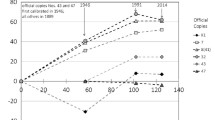Abstract
The International System of Units (SI) was first adopted in 1960, as the more recent implementation of the Metre Treaty signed in 1875. Basic features of the original SI are that (a) seven units are chosen as “base units”, all the others being “derived units”, and (b) the definitions of the base units should not create interdependence. This way, the SI conforms to the basic principle of the Metre Treaty that each signatory country can realise its choice of primary national standards of the very definitions of the units without needing to resort to calibrations obtained from another country, and without obligation to have them realised for all the units. A mismatch already occurs to some extent with respect to the above features in the present definitions of SI base units. This contribution, strictly based on metrological considerations, illustrates how the present proposal concerning new definitions for the base units, called “New SI”, would extend the mismatch. In this frame, also the meaning is discussed of the concepts of hierarchy and traceability in metrology. By outlining some of the consequences, a discussion is stimulated related to the status of base unit, to the meaning of calibration at the level of the standards of the unit definitions, and to the interdependence of countries’ standards.
Similar content being viewed by others
References
Bureau International des Poids et Mesures. http://www.bipm.org/en/convention/. See: Metric Convention of 1875, Paris, 20 May 1875 http://lamar.colostate.edu/~hillger/laws/metric-convention.html
Bureau International des Poids et Mesures, SI Brochure. http://www.bipm.org/en/si/si_brochure/
CCU (2013) Draft 9th SI Brochure. Bureau International des Poids et Mesures http://www.bipm.org/en/si/new_si/:si_brochure_draft_ch123_131216
Evenson KM, Wells JS, Petersen FR, Danielson BL, Day GW, Barger RL, Hall JL (1972) Phys Rev Lett 29:1346–1349
Mulligan JF (1976) Am Phys 44:960–969
Cohen ER, Taylor BN (1987) Rev Mod Phys 59:1121–1148
Price G (2010) Accred Qual Assur 15:421–427
Price G (2010) Accred Qual Assur 15:477–484
CIPM (1999) Mutual recognition of national measurement standards and of calibration and measurement certificates issued by national metrology institutes (MRA). Bureau International des Poids et Mesures, Sèvres. http://www.bipm.org
Pavese F (2013) Mathematical and statistical tools in metrological measurement. In: Physical methods, instruments and measurements [UNESCO-EOLSS Joint Committee Ed]. Encyclopedia of Life Support Systems (EOLSS), Developed under the Auspices of the UNESCO, Eolss Publishers, Oxford, UK. http://www.eolss.net
Bureau International des Poids et Mesures. http://kcdb.bipm.org
BIPM (2012) International vocabulary of basic and general terms in metrology (VIM), 3rd edn. BIPM/ISO, JGCM 200:2012. 2008 version with minor corrections. http://www.bipm.org/en/publications/guides/vim.html
De Bièvre P (2013) Accred Qual Assur. doi:10.1007/s00769-013-0973-z
Pavese F (2014) Metrologia 51:L1–L4, with online Supplementary Information
Bureau International des Poids et Mesures. http://www.bipm.org/en/si/new_si/mise-en-pratique.html
CODATA. http://physics.nist.gov/cuu/Constants/index.html, BIPM. http://www.bipm.org/extra/codata/
De Bièvre P (2011) Accred Qual Assur 16:117–120
Pavese F (2011) Accred Qual Assur 16:161–165
Consult. http://www.metrologybytes.net
De Bièvre P (2010) Accred Qual Assur 15:437–438
Pavese F (2009) Metrologia 46:L29–L32
Pavese F (2010) Accred Qual Assur 15:305–315
Bronnikov KA, Melnikov VN (2011) Meas Tech 53:1196–1203
Cohen ER, Taylor BN (1973) J Phys Chem Ref Data 2:663–734
Physikalisch-Technische Bundesanstalt. http://www.ptb.de/cms/en/fachabtellungen/fb-44/ag-441/realisation-of-the-si-second/history-of-the-unit-of-time/ (consulted 2013.11.29)
Mohr PJ, Taylor BN, Newell DB (2012) Rev Mod Phys 84:1–94
Pavese F (2013) Measurement 46:3725–3729
Author information
Authors and Affiliations
Corresponding author
Additional information
Papers published in this section do not necessarily reflect the opinion of the Editors, the Editorial Board and the Publisher.
A critical and constructive debate in the Discussion Forum or a Letter to the Editor is strongly encouraged!
Appendix
Appendix
The numerical values of the units deriving from the proposed new definitions using constants are shown in Table 3, where the asterisk indicates stipulated values: for this purpose, the CODATA 2010 adjusted values are used here as they are in [3]—but see [14] about problems in using CODATA values.
The method of computation of the uncertainties in column 4 of Table 3 is not un-ambiguous, since c 0 and Δν(133Cs) are already stipulated at the present time.
The original uncertainties of c 0 and Δν(133Cs) at the moment of their stipulation are known: for c 0 the datum of the Comité Consultatif pour la Définition du Mètre (CCDM, 1983) is indicated in [25]: c 0 = (299 792 458.33 ± 0.6) m s−1. The value Δν(133Cs) = (9192 631 770 ± 20) s−1 was drawn from [26]. Then, the usual propagation law of these uncertainties, and of those associated to h ({u(h)} = 29×10−42), e ({u(e)} = 35×10−28), k B ({u(k B)} = 13×10−30) and N A ({u(N A)} = 27×10−31) [27], was used here to obtain the reported figures in the last column of Table 3.
The uncertain numerical values should be used as criteria for truncation of the stipulated numerical values [28].
Rights and permissions
About this article
Cite this article
Pavese, F. How much does the SI, namely the proposed “New SI”, conform to principles of the Metre Treaty?. Accred Qual Assur 19, 307–314 (2014). https://doi.org/10.1007/s00769-014-1063-6
Received:
Accepted:
Published:
Issue Date:
DOI: https://doi.org/10.1007/s00769-014-1063-6



